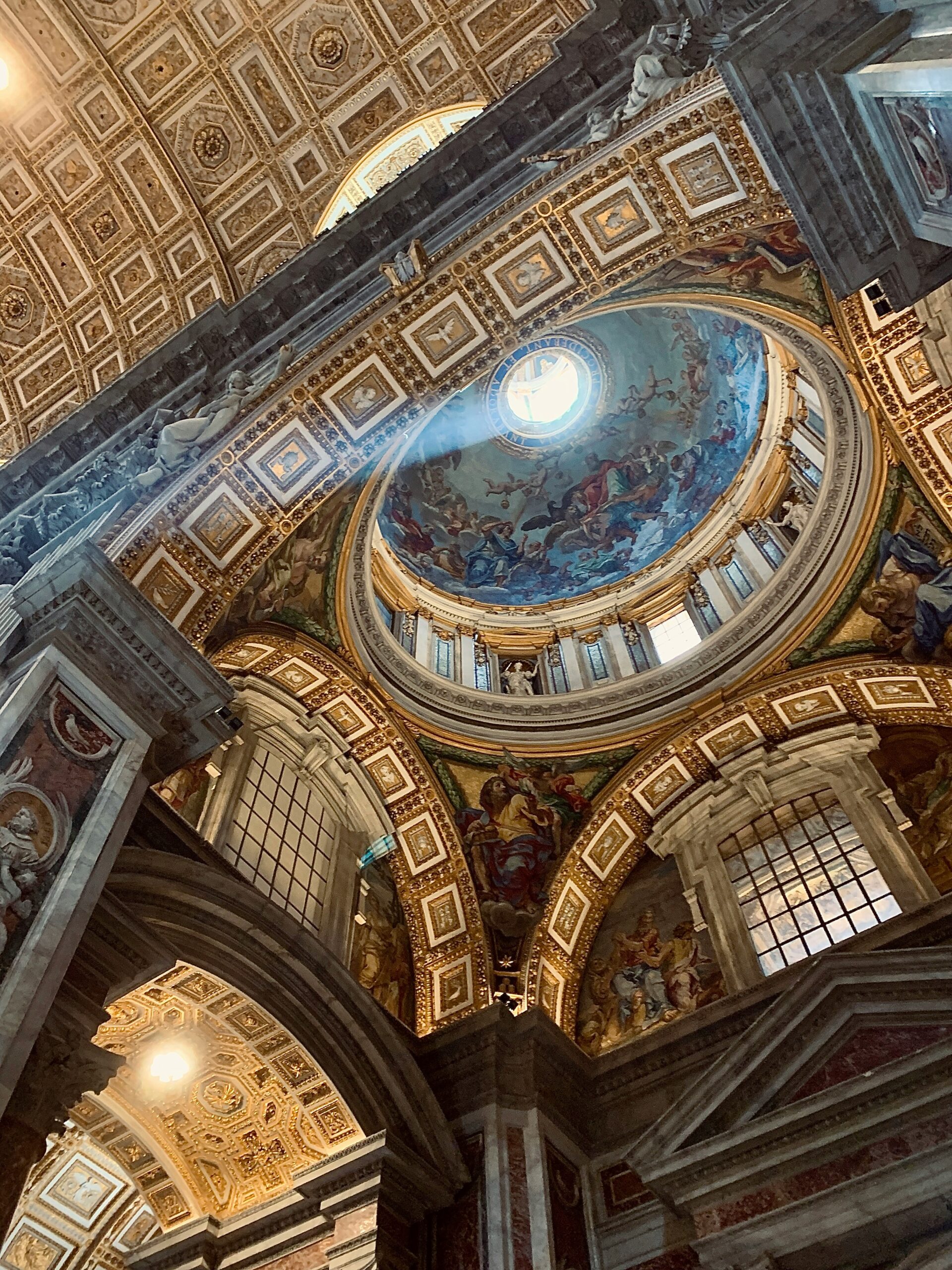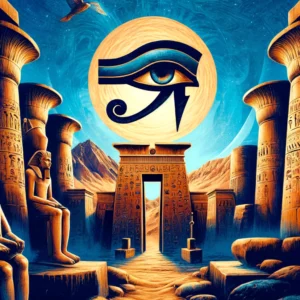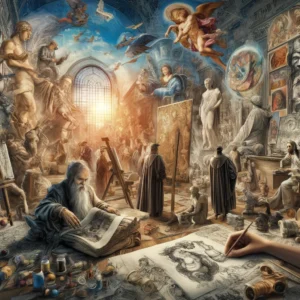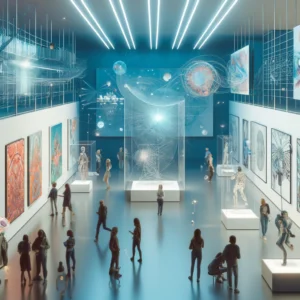
Introduction
Welcome to the captivating world of art history! In this blog post, we will embark on a fascinating journey through time, exploring the works of the masters of art. From ancient civilizations to modern-day marvels, we will delve into the rich tapestry of human creativity and expression. So, fasten your seatbelts and get ready to travel through time with the masters of art!
Art has always been an integral part of human civilization. It is a reflection of our thoughts, emotions, and experiences, serving as a window into the past and a catalyst for change in the present. Throughout history, artists have pushed the boundaries of imagination and challenged societal norms, leaving behind a legacy that continues to inspire and captivate us today.
Our journey begins in the ancient world, where civilizations like the Egyptians, Greeks, and Romans left behind breathtaking works of art that still astound us with their beauty and craftsmanship. From the intricate hieroglyphics of the Egyptians to the lifelike sculptures of the Greeks, these ancient civilizations laid the foundation for the art that would follow.
As we move forward in time, we encounter the Renaissance, a period of great cultural and artistic rebirth in Europe. During this time, artists like Leonardo da Vinci, Michelangelo, and Raphael emerged, revolutionizing the art world with their mastery of perspective, anatomy, and composition. The Renaissance was a time of great innovation and experimentation, as artists sought to capture the human form in all its complexity and beauty.
From the Renaissance, we journey through the Baroque period, where artists like Caravaggio and Rembrandt explored themes of light and shadow, creating dramatic and emotionally charged works of art. The Baroque period was characterized by a sense of grandeur and theatricality, with artists using dramatic lighting and intense colors to evoke powerful emotions in their viewers.
As we move into the 19th and 20th centuries, we witness the birth of new artistic movements, such as Impressionism, Cubism, and Surrealism. Artists like Monet, Picasso, and Dali challenged traditional notions of representation, experimenting with new techniques and perspectives. These movements marked a shift towards greater abstraction and a rejection of traditional artistic conventions.
Finally, we arrive at the present day, where art continues to evolve and push boundaries. Contemporary artists are using new technologies and mediums to create immersive and interactive experiences, blurring the lines between art and technology. From virtual reality installations to digital art, the possibilities for artistic expression are endless.
Throughout this journey, we will explore the works of these masters of art, analyzing their techniques, themes, and influences. We will also examine the social, political, and cultural contexts in which these artists lived and worked, gaining a deeper understanding of how their art reflects and shapes the world around them.
So, join me as we embark on this exciting adventure through the world of art history. Together, we will unravel the mysteries and marvels of the past, and gain a greater appreciation for the power and beauty of art.
As we delve deeper into the world of ancient art, we cannot overlook the contributions of the Mesopotamians, who were pioneers in many artistic techniques that still influence artists today. The Mesopotamians, who inhabited the region between the Tigris and Euphrates rivers, were skilled in various forms of art, including pottery, metalwork, and architecture.
One of the most notable examples of Mesopotamian art is the Ishtar Gate, which was built in the ancient city of Babylon. This monumental structure, adorned with vibrant blue glazed bricks and intricate reliefs of dragons and lions, served as a grand entrance to the city. The Ishtar Gate not only showcased the artistic prowess of the Mesopotamians but also reflected their religious beliefs, as it was dedicated to the goddess Ishtar.
Moving further east, we encounter the rich artistic heritage of ancient China. Chinese art, with its emphasis on harmony, balance, and symbolism, has captivated audiences for centuries. One of the most iconic forms of Chinese art is calligraphy, which is considered not only a means of communication but also a form of artistic expression. The intricate brushstrokes and elegant characters of Chinese calligraphy are a testament to the meticulous craftsmanship and aesthetic sensibility of ancient Chinese artists.
Moreover, ancient Chinese art is also renowned for its exquisite ceramics. From the delicate blue-and-white porcelain of the Ming Dynasty to the vibrant and colorful Tang Dynasty pottery, Chinese ceramics showcase the mastery of techniques such as glazing, kiln firing, and intricate decoration. These ceramics not only served practical purposes but also represented the cultural and artistic achievements of ancient China.
As we continue our exploration of ancient art, we cannot overlook the artistic contributions of the Mayans in Mesoamerica. The Mayans, known for their advanced civilization and astronomical knowledge, left behind a rich artistic legacy that includes intricate stone carvings, vibrant murals, and awe-inspiring pyramids.
One of the most remarkable examples of Mayan art is the hieroglyphic writing system they developed. Similar to the Egyptian hieroglyphs, Mayan hieroglyphs were a complex system of symbols that allowed the Mayans to record their history, mythology, and astronomical observations. These hieroglyphs were often carved into stone monuments and stelae, providing a lasting record of the Mayan civilization and its achievements.
From the pyramids of Egypt to the pottery of ancient China, ancient art offers us a window into the past, allowing us to connect with the artistic expressions of our ancestors. These works of art not only showcase the skill and creativity of ancient civilizations but also provide valuable insights into their beliefs, values, and cultural practices. By studying and appreciating ancient art, we can gain a deeper understanding of our shared human heritage and the universal power of artistic expression.
In addition to the visual arts, the Renaissance also witnessed significant advancements in literature. One of the most influential writers of this era was William Shakespeare. His plays, such as “Hamlet,” “Romeo and Juliet,” and “Macbeth,” are still performed and studied today, showcasing his profound understanding of human nature and his ability to craft complex characters.
Furthermore, the Renaissance was not limited to the arts alone; it also saw remarkable advancements in science and technology. Figures like Galileo Galilei and Nicolaus Copernicus revolutionized our understanding of the universe through their groundbreaking astronomical discoveries. Galileo’s invention of the telescope allowed him to observe celestial bodies in unprecedented detail, confirming Copernicus’ heliocentric model of the solar system.
Moreover, the Renaissance was a time of exploration and discovery. The voyages of Christopher Columbus, Vasco da Gama, and Ferdinand Magellan opened up new trade routes and expanded European knowledge of the world. These expeditions not only brought wealth and resources to Europe but also fostered cultural exchange and the exchange of ideas.
It is important to note that the Renaissance was not a homogeneous period; it varied across different regions of Europe. For example, the Northern Renaissance, centered in countries like Germany, the Netherlands, and England, had its own distinct characteristics. Artists like Albrecht Dürer and Jan van Eyck excelled in the use of oil painting techniques and brought a unique perspective to the Renaissance movement.
In conclusion, the Renaissance was a transformative period in human history that witnessed a rebirth of artistic genius, scientific discovery, and exploration. It was a time when the individual was celebrated, and humanism became a driving force behind cultural and intellectual pursuits. The works of Leonardo da Vinci, Michelangelo, Shakespeare, and many others continue to inspire and captivate us, reminding us of the enduring legacy of this remarkable era.
Impressionism, as an art movement, emerged in the late 19th century in France. It was a reaction against the rigid rules and standards set by the French Academy of Fine Arts. Impressionist artists sought to break free from the constraints of traditional art and explore new ways of representing the world around them.
One of the key characteristics of Impressionism is the emphasis on capturing the immediate and transient qualities of a scene. Instead of meticulously rendering every detail, Impressionist artists aimed to convey the overall impression or feeling of a moment. They achieved this through the use of loose brushstrokes, which gave their paintings a sense of spontaneity and movement.
The choice of subject matter was also a departure from the norm. While the Academy favored historical and mythological themes, Impressionist artists turned their attention to everyday life and the natural world. They sought inspiration in the mundane and ordinary, finding beauty in the fleeting moments of modern life.
Claude Monet, with his series of water lilies, perfectly exemplifies the Impressionist approach. His paintings depict the ever-changing play of light and color on the surface of the water, capturing the essence of a moment in time. Monet’s brushstrokes are loose and expressive, creating a sense of movement and atmosphere. The result is a series of paintings that transport the viewer to a serene and dreamlike world, where nature becomes the protagonist.
Edgar Degas, on the other hand, focused on the human figure, particularly ballet dancers. His paintings of dancers in motion are a testament to his keen observation and understanding of human anatomy. Degas captured the grace and fluidity of the dancers’ movements, using unconventional compositions and pastel colors to add a unique touch to his works. His paintings are instantly recognizable, with their distinctive blend of realism and abstraction.
Impressionism, with its emphasis on capturing the essence of a moment, had a profound impact on the art world. It challenged the established norms and paved the way for new artistic movements, such as Post-Impressionism and Fauvism. The legacy of Impressionism can still be seen in contemporary art, where artists continue to explore new ways of representing the world around them.
Modern art is not limited to painting and sculpture; it extends to various mediums, including photography, installation art, performance art, and even digital art. With the advent of new technologies and the ever-evolving nature of society, artists have found new ways to express their ideas and challenge conventional artistic practices.
Photography, for instance, has played a significant role in shaping modern art. Artists like Man Ray and Cindy Sherman have used photography as a means to explore identity, gender, and the concept of the self. Through their lens, they capture moments that are both staged and spontaneous, blurring the lines between reality and fiction.
Installation art, on the other hand, immerses the viewer in a multisensory experience. Artists like Yayoi Kusama and Olafur Eliasson create immersive environments that challenge our perception of space and time. Their installations often incorporate elements of light, sound, and interactive components, inviting the viewer to actively engage with the artwork.
Performance art takes art out of the confines of the traditional gallery space and into the realm of live action. Artists like Marina Abramović and Yoko Ono have used their bodies as a medium, pushing the boundaries of what is considered art. Their performances often involve endurance, vulnerability, and audience participation, creating a unique and transformative experience for both the artist and the viewer.
With the rise of digital technology, artists have embraced new tools and platforms to create art that exists solely in the virtual realm. Digital art encompasses a wide range of practices, from computer-generated imagery to interactive installations. Artists like Refik Anadol and Ian Cheng use algorithms and artificial intelligence to create immersive and ever-evolving artworks that challenge our perception of reality.
In conclusion, modern art is a diverse and ever-evolving field that continues to push the boundaries of what art can be. Through various mediums and techniques, artists challenge conventional norms, explore new ideas, and invite us to see the world in a different light. Whether it’s through painting, photography, installation art, performance art, or digital art, modern artists continue to inspire and provoke us, encouraging us to question the status quo and embrace new possibilities.
potentially a book chapter on this subject, you might consider consulting a variety of sources that delve deeper into specific eras, key figures, and artistic movements. Here are some types of sources and specific recommendations you might find useful: 
- Books on Art History:
- “The Story of Art” by E.H. Gombrich – This is a comprehensive and accessible introduction to the visual arts, ideal for understanding the progression of art movements throughout history.
- “Art: A Visual History” by Robert Cumming – Includes timelines, profiles of key artists, and analyses of significant artworks.
- Scholarly Articles and Journals:
- Art Bulletin – A leading journal of art history, perfect for deep dives into specific artworks or movements.
- Journal of Art Historiography – Offers critical perspectives on art history’s methods and practices.
- Online Databases and Resources:
- JSTOR and Google Scholar – These platforms provide access to scholarly articles across various subjects, including detailed studies on art history.
- Artstor – A digital library with millions of high-quality images of artworks from museums around the world, alongside detailed curatorial notes.
- Museum Collections and Exhibitions:
- Websites of major museums like The Louvre, The Metropolitan Museum of Art, and The British Museum often have extensive online collections with high-quality images and detailed discussions of their holdings.
- Documentaries and Video Series:
- “The Power of Art” by Simon Schama (BBC series) – This series features dramatic recreations and engaging narratives about key figures in art history.
- Khan Academy’s Art History Series – Offers free, comprehensive video lessons on different art historical periods and styles.
- To cover the broad spectrum of art history thoroughly, you’ll benefit from diverse resources spanning different periods and movements. Here’s a structured approach to access detailed resources for each significant era and movement mentioned in your overview:
Ancient Art

Renaissance Art – Depicting a vibrant workshop with famous artists and their works. - Books: “The Art and Architecture of Ancient Egypt” by W. Stevenson Smith provides in-depth insights into Egyptian art.
- Online Resource: The Metropolitan Museum of Art’s Heilbrunn Timeline of Art History offers extensive articles and images on ancient civilizations like the Greeks, Romans, and Egyptians.
Renaissance Art
- Books: “The Lives of the Artists” by Giorgio Vasari offers firsthand biographies of Renaissance masters like Leonardo da Vinci and Michelangelo.
- Scholarly Database: JSTOR provides access to scholarly articles focusing on Renaissance studies.
Baroque Art
- Books: “Baroque and Rococo” by Germain Bazin covers key artists and thematic elements of the period.
- Museum Collections: The Louvre’s online database features prominent Baroque artists like Caravaggio and Rembrandt.
Impressionism and Modern Movements
- Books: “Impressionism: Art, Leisure, and Parisian Society” by Robert Herbert explores the roots and impacts of Impressionism.
- Documentary: “The Impressionists” by BBC offers visual insights into the lives and works of artists like Monet and Degas.
Contemporary Art

Impressionist Art Exhibition – Showcasing a gallery scene with vibrant colors and everyday life scenes. - Online Resource: Artstor’s digital library includes contemporary works with high-resolution images and scholarly annotations.
- Documentary: “The Art of the 21st Century” series by Art21 showcases contemporary artists and their innovative approaches to art making.
Accessing Scholarly Articles and Databases
- JSTOR and Google Scholar: Use these platforms to find specific articles on art historical topics. You may need institutional access; check if your local library offers access or consider applying for access through programs like JSTOR for individuals.
Viewing Art Online

Modern Art Gallery – Displaying a contemporary gallery with diverse forms of modern artwork. - Google Arts & Culture: This site provides virtual tours of museums and high-resolution images of artworks from around the world.
Watching Documentaries
- Kanopy: Many educational institutions provide free access to this streaming service, which includes a wealth of documentaries on art and artists.
Books on Art History
Scholarly Articles and Journals
- JSTOR – A digital library for scholarly articles across many disciplines, including art history.
- Artstor – Digital library of artistic images and associated scholarly information.
Museum Collections
Documentaries and Video Series
Online Book Retailers
- Amazon – For purchasing books like “The Lives of the Artists” by Giorgio Vasari.
- Google Books – For previewing and purchasing books.
Viewing Art Online
- Google Arts & Culture – Explore high-resolution images of artworks and virtual museum tours.
Watching Documentaries
- Kanopy – A streaming service that offers educational and arts-focused documentaries. Access may require a library card or university affiliation.
These resources will provide comprehensive insights into various art movements, critical analyses, visual examples, and scholarly discussions, which can greatly enhance your understanding and presentation of art history.






